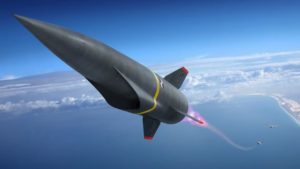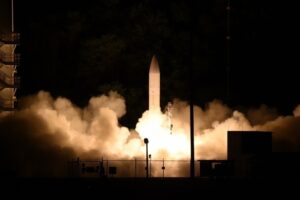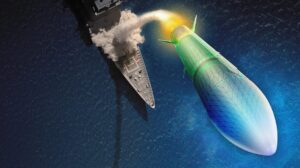SAN DIEGO– Two Navy researchers last month outlined some major limitations on adding and using hypersonic weapons., focused on physics limitations combined with expense.
“So there is an advantage to speed. They also help survivability, [but also] they’re very expensive,” David Kiel, director of the Directed Energy Warfare Office at the Office of Naval Research, said during a Feb. 14 panel discussion at the West 2023 conference, sponsored by AFCEA International and the U.S. Naval Institute.

Kiel underscored news reports where Russia claimed it fired one hypersonic missile at a target in Ukraine and it did not hit the target as an example of their limitation.
“Now it’s Russia, take that for what it’s worth, [but] I’m not too sure hypersonics is a radical game changer because they’re going to be hard to produce and afford in quantity. Maybe that’s okay, if you’re just going to use them for the exquisite targets and that’s kind of it,” he said.
Kiel said he personally believes quantity has a quality of its own in relation to hypersonic missiles.
“If you get some missiles that you can afford thousands of instead of tens of, you will actually have a bigger outcome on the war, even though they’re not as capable.”
Researcher Lt. Cmdr. Brian Curran also pointed out some of the physics issues designers have to contend with that inevitably lead to their high expense, focusing on communications and sensors, withstanding high speed and temperature, dissipating that heat, and making the engines work at high speeds.
“Part of the reason why hypersonics are such a challenge is because it’s a difficult problem. From a design standpoint, any sort of hypersonic system has just got tremendous things it has to cover,” Curran, a PhD candidate in applied physics at the Naval Postgraduate School, said. He has previously worked in both laser and ballistic missile defense roles between previously receiving master’s degrees in applied physics and mechanical engineering and his current PhD research.
He said after a vehicle or projectile gets past Mach Five, it develops a plasma sheath that makes communications and sensors difficult, if not impossible, to penetrate.
“Think about back in the days of the Apollo missions, whenever the Apollo capsule was coming back into Earth, there was the communications blackout. And what that meant was basically you had that plasma sheath around the Apollo capsule that was preventing [radio frequency] signals from going across. And it’s the same kind of thing that will basically form around any hypersonic body. So that’s a challenge,” Curran said.
He also said the materials have to deal with “huge challenges” in withstanding incredibly high speeds and temperatures, “so how do you basically prevent whatever this vehicle is from melting? You need exotic materials. Exotic materials wind up being expensive.”
Then once they even have the exotic materials to withstand one set of physics issues, the designers also have to be able to dissipate the heat.

“If you just basically apply a constant blowtorch to one part of that missile and just leave it there, without taking the heat away, it’s going to melt eventually. So, basically, you have to have ways of dissipating that heat within the missile and transferring it within the missile, so that it doesn’t overheat and just simply, you know, vaporize, if you will.” Curran continued.
Curran also outlined the challenges in sustaining hypersonic propulsion itself.
He said while a ramjet takes supersonic air, slows it to subsonic speeds, mixes it with fuel and then ignites it and expels it out the back, weapons operating at hypersonic speeds with scramjets have to deal with intake air staying supersonic the entire way through the engine body.
“So that means you have to, in a very short period of time, mix your fuel, oxidize your fuel, burn it and have all the burning occur by the time it actually exits what is a very short cylinder,” Curran said.
He argued that means hypersonic missile designers need to use high end fuels and very careful mixing mechanisms to be able to work the engine properly. Curran also underscored if the engine does not work precisely right, any fuel sent out the back has a “fairly low specific impulse for any amount of fuel because of this.”
Curran underscored these are just a few of the “tremendous design challenges” in hypersonic weapon design and production.

“But in order for you to take a system that we want to employ, be it a hypersonic cruise missile or hypersonic glide vehicle, we have to be able to address all those things. And that means lots of funding, lots of tests, lots of very smart people working on it. And it is, unfortunately, a very involved process.”
The Army is set to deploy its initial unit this year with a truck-launched version of a shared hypersonic all-up-round. The Navy plans to install the weapon, which it calls Conventional Prompt Strike (CPS), on the three Zumwalt-class destroyers, starting with an 18-month drydock availability later this year. The first test shots of the CPS off of USS Zumwalt (DDG-1000) are due to occur by December 2025.
Then, by 2029, the Navy plans to install CPS on the first Virginia-class submarine with the Virginia Payload Module.